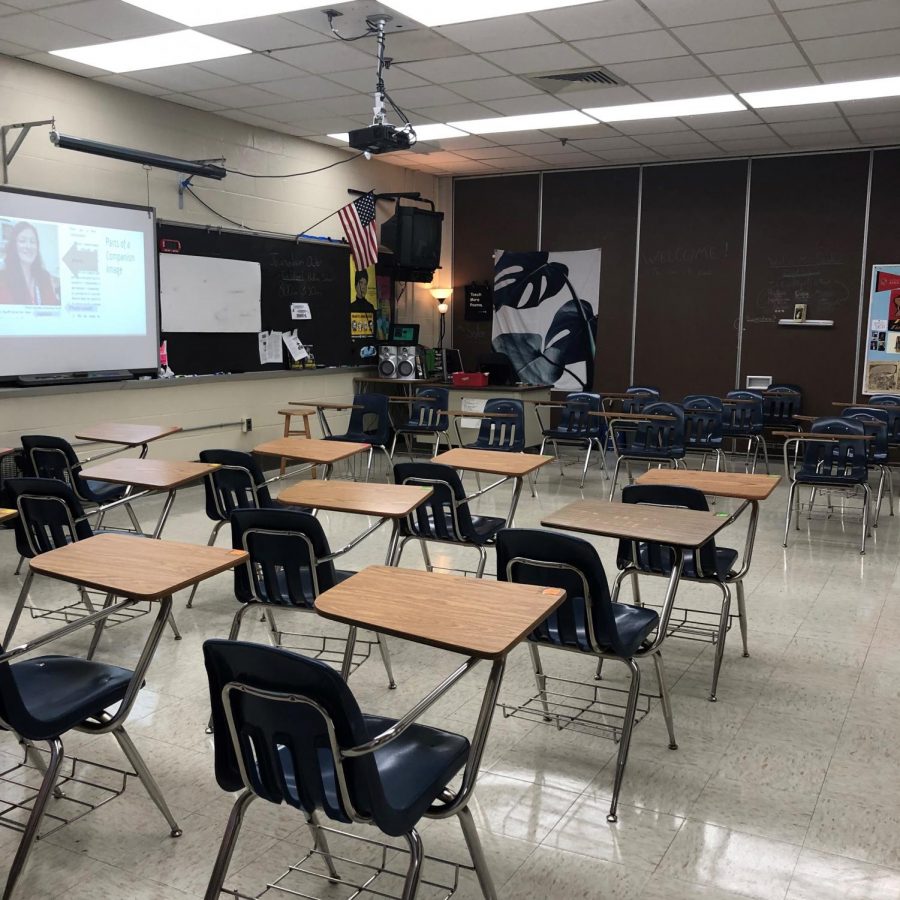Social Distancing Difficulties at ERHS
A socially distanced classroom at ERHS.
November 2, 2021
As ERHS students and staff return to in-person school in the midst of the COVID-19 pandemic, social distancing guidelines present a unique challenge inside and outside of the classroom.
On August 5, 2021, the Centers for Disease Control (CDC) updated their guidelines for the safest possible return to in-person schooling. According to their website, “CDC recommends schools maintain at least 3 feet of physical distance between students within classrooms to reduce transmission risk,” in addition to a universal indoor mask requirement. The CDC also strongly encourages students and staff to receive the COVID-19 vaccine, as it is “the leading public health prevention strategy to end the COVID-19 pandemic.” However, because the COVID-19 vaccine has not yet been approved for children under 12, the CDC encourages layering many different prevention strategies—such as universal masking, social distancing, and screening testing—in order to best protect young students.
ERHS is following safety guidelines from the CDC, as stated in the PGCPS reopening plan announced in the weeks leading up to the 2021-22 school year. According to the full reopening plan, classrooms must “space seating/desks at least 3 feet apart when feasible,” while teachers “will assign seats to students to assist with contact tracing.” The reopening plan specifically states that all guidance comes directly from the CDC, but implementation may vary based on each building’s size and configuration.
At ERHS, many students have concerns about how well social distancing guidelines have been applied and enforced. Inside the classroom, not having adequate space for social distancing is an issue for many larger classes. Senior Rahel Mani is particularly concerned about her AP Statistics class, which has 40 students in it. She stated that “social distancing is not possible” given the number of students and the size of the classroom, and it “makes [her] feel unsafe.”
“I have to risk my safety and my classmates’ safety to get a proper education,” Mani said.
Some of the larger classrooms at ERHS, despite having more space for students, face their own challenges. Senior Sydney Endres is currently taking Drama 1, where “the room is large so [social distancing] is doable.” However, “performances can be difficult because [we] have to stage it correctly so everyone still has their space,” she added.
Another issue that students are noticing is in the hallways. During the transition between classes, it is nearly impossible to maintain any social distance and students are often so close that they bump into each other. “While the school does attempt to enforce social distancing rules, they tend to be exempt when we transition to our next class,” Mani said. Endres agreed, stating that “the hallways are extremely chaotic and unsafe” during transitions. “There are so many people there at once,” she added, “and everyone is bumping into [each other.]”
“I don’t really know how safety could be any better just because we don’t have the resources and we have way too many students to handle,” Endres concluded.
However, there are many ways that students are incorporating the CDC recommendation of layering protection methods. Abiding by the mask mandate, following the seating chart rules, and using the hand sanitizer available in every classroom are just a few of the ways that students can protect themselves.




